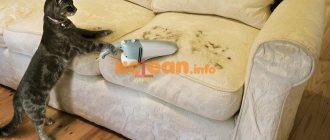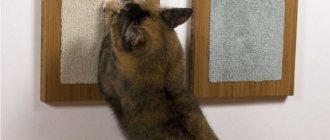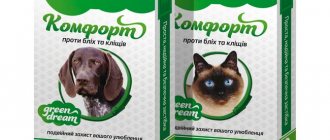Domestic cats are the ancestors of wild predators, so they have a lot of qualities necessary for productive hunting. One of the important criteria for a cat is hearing. The owner’s responsibilities should include not only timely and high-quality feeding, but also proper hygienic care of the pet.
It is necessary to pay special attention to the condition of the ears, regularly checking for discharge, redness or other pathological changes. The appearance of a specific brown plaque in the inner part of the auricle indicates insufficient ear hygiene. But if other signs appear, such as depression, itching, unpleasant odor from the ear, you need to contact a veterinary clinic for help. After all, these signs indicate the development of pathology.
Discharge from cat ears: common causes
When your cat's ears are healthy, they are pink and clean inside, odorless, have very little or no wax, and seem to be able to detect the sound of their can opener from a mile away.
When your feline friend has ear problems, you may notice a very different cat.
Symptoms of ear problems in cats include pawed ears, sensitivity to touch, large amounts of cream, orange, dark brown or black wax; hearing loss; tilting or shaking the head; and loss of balance.
The most common causes of ear discharge in cats include:
Stages of the procedure
- Before use, the lotion must be warmed in your hand so that cold drops do not cause discomfort to the animal.
- Then the bottle must be shaken vigorously for several seconds.
- Open the cap and place 2-5 drops of the product on the inside of the ear.
- Massage the base of the ear in a circular motion to better distribute the liquid.
- Using a cotton pad soaked in lotion, wipe the ear from the inside to the edges, paying attention to each fold.
The process is presented more clearly in our video.
After cleaning, treat your pet to his favorite treat. The cat should associate the process with pleasant moments so that it is easy to carry out in the future.
Ear infections
This is serious business. Ear infections not only cause serious discomfort for your cat, but if left untreated, they can lead to permanent deafness or the need for surgery.
Ear infections in cats can be caused by a variety of reasons, including debris in the ear canal, wax buildup in the ear canal, allergies to food or pollen, autoimmune diseases, thick fur in the ear canal, a ruptured eardrum, drug reactions, tumors or polyps. in the ear canal and environmental irritants.
What you need to prepare before the procedure
- Clean cotton pads, swabs, or small soft wipes.
- Cosmetic and hygienic lotion for cleaning the ears.
Do not use shampoos, soap solutions or other liquids. They can harm your pet's health.
You should also not use hygienic sticks or matches wrapped in cotton wool for three reasons:
- The animal may jerk its head during the procedure, which carries the risk of damage to the ear canal.
- During the cleaning process, the cotton part may remain in the ear, which is dangerous for the pet.
- There is a risk of scratching the inside of the ear with a hard object, which can cause infection.
Treatment for cat ear mites
Ear mites can breed inside your cat's ear by eating earwax and sebum. Your veterinarian will likely diagnose an ear mite infection by checking a sample of your cat's earwax under a microscope.
Treatment for ear mites usually involves cleaning the ears well and taking a prescription topical medication. Injectable medications are also available for uncooperative cats.
Ear mites can be highly contagious in pets, so if you find that your cat has them, you may want to have the rest of your family's four-legged friends checked by your veterinarian as well. Most likely, your entire pet will need treatment for ear mites, otherwise the infestation can easily recur.
Causes and consequences of earwax accumulation
If wax appears in your cat's ears, you need to find out why it occurred. There may be several reasons :
- natural ear contamination;
- intensive work of the sulfur glands (depending on the breed);
- excessive cleaning of the ear;
- diseases of the pet (mites, otitis media);
- foreign object in the ear.
When examining the ears, special attention should be paid to the color of the wax. If it is black or dirty green in color, and even has an unpleasant odor, this is a symptom of a dangerous disease.
The black color of wax may be due to dried blood from an ear injury. Another reason is an infested tick. Its waste products give it a black color. Brown purulent discharge with an unpleasant odor is a consequence of infectious diseases. The fungal nature of the disease also produces dark discharge. For a correct diagnosis, it is recommended to contact a veterinary clinic.
Regular care of your pet's ears will relieve him of unpleasant consequences . Excessive accumulation of sulfur can lead to complete or partial loss of hearing, disorientation of the animal in space, nausea, and vomiting. An inflammatory process may begin that will affect the animal’s brain, since the ears are directly connected to it.
© shutterstock
Preventing cat ear problems
To keep your cat's ears healthy and pest-free, check their ears regularly for signs of wax buildup, inflammation, or odor. If you notice a problem, it's time to talk to your veterinarian.
Cats' ears are expressive, beautiful - and very fragile. To avoid damaging the eardrum or collecting wax deep in the ear, never insert anything into your cat's ears or use over-the-counter medications unless your veterinarian has shown you the correct way to do so.
It's easy to misinterpret cat ear discharge as mites when it's something else, or to leave a mild infection untreated until it becomes severe or chronic.
Don't let your cat guess - always talk to your veterinarian if you suspect you have an ear problem.
Otomycosis: when fungi grow in the ears
When mentioning fungal diseases in humans, most of us will probably only remember nail fungus or thrush. But it turns out that there are also mushrooms that grow in the ears and cause a lot of trouble to a person. The pathological process caused by fungi in the ears is called otomycosis.
What is fungal otitis and how does it happen?
Otomycosis is a disease of various parts of the ear, which is caused by certain types of mold and yeast-like fungi. Most often, the causative agent of the pathological process is fungi from the genus Aspergillus
and
Candida
.
Otomycosis is a kind of collective concept that indicates the fungal nature of ear pathology. The specific name of the disease depends on which part of the ear is affected: if the auricle and skin of the external auditory canal are involved in the pathological process, this is fungal external otitis; if the process spreads to the eardrum, they speak of fungal myringitis; if the tympanic cavity (middle ear) is affected, then it is fungal otitis media.
What causes otomycosis?
As a rule, those fungi that cause otomycosis are classified as opportunistic, i.e. they cause the disease only if there are predisposing factors. Factors that increase the risk of otomycosis include:
- injuries to the skin of the auricle and auditory tube (most often due to improper hygiene of the outer ear, the use of cotton swabs, as well as allergic diseases accompanied by itching and scratching), which increase the risk of the fungus penetrating the skin and opening the gates of infection;
- existing inflammatory diseases of the ear, since local immunity is significantly reduced;
- fungal infection of other localizations, for example, fungus of the nail plate, foot, thrush, etc. Most often, a fungal infection manifests itself against the background of decreased immunity and changes in the composition of the skin microflora. Disturbances occur throughout the body, so if a fungal infection appears in one place, there is a chance that it will manifest itself somewhere else;
- diabetes mellitus - sugar, the content of which in earwax increases significantly during this disease, is a good nutrient medium for fungi and promotes their growth;
- concomitant chronic diseases that lead to a decrease in the body’s overall resistance;
- taking antibiotics, glucocorticosteroids, cytostatics - long-term and irrational use of these drugs leads to changes in the normal composition of the skin microflora and the development of pathogenic microorganisms.
Symptoms of the disease
Most often, otomycosis affects the ear on only one side. Manifestations of the disease depend on which part of the ear is affected. The common feature is the gradual onset of the disease and the progression of symptoms as the mycelium of the fungus grows into the thickness of the skin.
For external otomycosis
The disease begins with swelling of the external auditory canal, gradually accompanied by itching, pain, and a feeling of ear congestion. Later, discharge from the external auditory canal appears. The nature of the discharge depends on the type of fungus: with candidiasis, it is a liquid, cheesy discharge, often white or yellowish in color; with aspergillosis, it is a thick discharge, ranging in color from green to gray-black.
Headband with veil
Such decoration will add mystery to the image, sexuality and romance, and is very easy to do. So, how to make a headband with cat ears and a veil:
- prepare a familiar decoration as a base;
- black lace;
- threads with a needle;
- wire;
- mesh for veil.
If the base is black and looks good, then you don’t need to wrap it with a satin ribbon; if you want the product to look finished, then wrap it for beauty.
Now twist two cat ears from wire and cut them out of lace according to their size.
They will need to be sewn to the wire, and very carefully so that the accessory does not have a wrong side.
After you have finished with the stage of attaching the “locators” to the rim, you can proceed to the final stage - attaching the veil. Simply cut a rectangle of the required size and stitch it to the base. You will get this beauty:
Oh, how fashion models and stars love such accessories. And it really looks very interesting!
We invite you to watch another master class - a headband with ears to consolidate the result:
Use in the diet of pets
In veterinary medicine, a feed sulfur additive is widely used, which is not applicable for cats and dogs. This sulfur is mainly used to feed cattle. For pets, medical or purified sulfur is produced in powder form, packaged in bags weighing 20, 50, and 100 g. Instructions for using the food additive “Sulfur for Animals” familiarize the cat owner with how and in what doses to add the substance to food for the cat. In addition, the owner should pay attention to the terms and rules for storing the product, which are indicated on the package. Mainly storage duration is 2 years. The powder must be kept in a hermetically sealed container or vacuum packaging. The place should be cool and protected from light. Should be kept away from children. Before adding this substance to your cat's diet, you should consult your veterinarian.
The easiest way to give your pet this remedy is by adding it to a portion of food.
Any cat will perceive sulfur as a treat. According to the instructions, complementary foods are administered as a food additive daily, 1 time per day, 0.05 g per 1 kg of pet. The daily dose should not exceed 1 g. If the drug is used in combination with medications for scabies, the dose is reduced to 0.04 g per kilogram of the cat’s body weight. Sulfur powder is added to dry food or cooked food. It should be noted that the product does not dissolve well in liquid, however, this does not prevent the cat from consuming it with pleasure. The course of treatment with this substance should not exceed 1 month.
In addition, sulfur-based ointments are widely used to treat skin diseases in cats. They promote rapid healing of wounds and the speedy restoration of healthy skin.
Return to contents
Ear cleaning at the veterinary clinic
In any veterinary clinic, professional ear cleaning is included in the list of basic services provided. To carry out this procedure for the first time, it is advisable to seek help from a veterinarian, who will explain the technology in detail, show everything clearly and give the necessary recommendations . Then you can perform all the manipulations yourself.
You can have your cat's ears professionally cleaned at your veterinary clinic.
Veterinarians advise owners of expensive elite animals that require more frequent and thorough cleanings (loose-eared animals, sphinxes, etc.) to contact a veterinary clinic approximately once a month for ear cleaning.
When do cats have their ears cleaned?
These procedures are divided into preventive and therapeutic. The first ones are carried out monthly to remove contaminants and excess sulfur. However, the frequency largely depends on the cat’s breed, nutrition, and individual characteristics.
Medical procedures are required when infected with a tick along with taking antifungal drugs and antibiotics. If the veterinarian has prescribed rinses or drops of the drug, the ears are first cleaned with lotion (saline). Cleaning is necessary every time medications are used, since parasites and microorganisms produce a large amount of byproducts that interfere with the absorption of medications.
The procedures are carried out according to the veterinarian's recommendations until he says that the cat is healthy.
Diagnosis and treatment of diseases
There are many factors leading to the appearance of pathological changes in the auricle of pets. Therefore, treatment at home without a preliminary examination by a specialist and the prescription of medications is not possible.
One antimicrobial agent is not enough. An integrated approach is needed. To make a diagnosis, special studies are necessary. The ear canal is examined by a veterinarian using a special instrument - an otoscope. The veterinarian can determine the degree of neglect of the pathology and the area of localization of inflammation.
An obligatory point in the diagnostic process is the determination of the functional stasis of the eardrum. The specialist must also determine the presence of tumor processes, foreign objects and other factors that can provoke the disease.
It is recommended to collect biological material from the ear and further study it under a microscope. Next, bacterial culture is carried out to determine the type of pathogenic microorganisms or fungi, as well as differentiation of parasites that cause inflammation.
Depending on the factors that triggered the development of ear disease in a cat, the doctor develops a treatment regimen. If a bacterial infection is diagnosed, a course of antibiotics is prescribed. The type of drug, dosage and duration of administration are determined by the attending veterinarian who studied the test results.
Glucocorticosteroids can relieve inflammation from the affected organ of hearing. For ear lesions caused by malfunctions in the functioning of body systems, therapy includes an integrated approach. Medicines are prescribed not only to eliminate discomfort in the ears, but also drugs that have an immunocorrective effect.
If an ear allergy is diagnosed, the doctor recommends regular cleaning of the ear canal using special solutions. Systemic spectrum antihistamines and drugs with polyunsaturated fatty acids (Omega-3 and Omega-6) are also prescribed. In some clinical cases, therapy includes taking corticosteroids in the form of ointments (topically), injections and tablets (orally).
If the reason that provoked the appearance of brown discharge from the cat’s ear is otodectosis, acaricidal agents are prescribed, aimed purely at destroying parasites. The therapy is long-term, lasting several weeks.
If the auricle is affected by yeast fungi, you need to be patient and undergo long-term treatment. Lack of timely assistance can lead to dangerous complications. Regular cleaning of the ear canal and treatment with specific antifungal agents are prescribed.
If treatment is not started promptly, the animal may suffer from dangerous complications. Otitis externa quite easily turns into otitis media and internal otitis.
Advanced forms of otitis media can cause inflammation in the structures of the brain and sepsis.
Limitations and side effects
When using sulfur according to the instructions, complications and unwanted reactions occur extremely rarely. However, failure to comply with the dosage, as noted by veterinarians from the Zoovet clinic, can lead to death of the pet. If you apply ointment to the animal's skin without confirming the diagnosis, you can seriously aggravate the cat's condition. Incurable wounds and burns may occur. You should not forget about the rules of personal hygiene of the owners
If you have an allergic reaction to this component, you need to take precautions by adding sulfur to your pet’s food. It is better to use rubber gloves and a gauze bandage.
How can you clean your ears safely?
It is better not to do this yourself, but to contact a specialist (an ENT doctor or a hearing prosthetist who is observing you). He has the tools and skills to clean your ears and remove wax plugs without causing harm. He will also be able to competently advise you on all issues related to ear hygiene. Usually, it is enough to pat them dry with a towel after a shower or bath.
If you suspect you have wax impaction, consult an audiologist
Deeply soiled cleaning
You can clean deep dirt as follows:
- The kitten is fixed in a comfortable position.
- A special product is instilled into the ear.
- The ear is gently massaged in the lower part - this way the drug is distributed evenly throughout the entire inner part.
- The animal is released so that the pet can shake its head.
- The kitten is picked up again, the cotton swab is immersed deeper, removing dirt
- Additionally, cleaning is carried out using a cotton pad.
- Similar manipulations are performed with the second ear.
How does the ear cleaning procedure work?
Before you begin to directly clean the ear, the cat should first be calmed and caressed. The animal should not be afraid or aggressive. It will be much easier for you to thoroughly clean the ear canal if the cat sits quietly in your arms or on a table. Make her comfortable and begin the procedure.
In order for you to have the opportunity to look inside the ear canal, you should slightly turn the cat’s ear out and shine a flashlight inside. This way you can assess the scale of the work and start cleaning. Soak a cotton swab or pad in a special product or put drops on it and run it along the inside of the ear from the depth to the tip. You should not roll a cotton swab or swab inside the ear, this will not give any result and will only create discomfort for the cat. Change the tampon every time it gets dirty and repeat the procedure until it remains clean. It is not necessary to bring your cat's ears to perfect cleanliness. The presence of a small amount of sulfur will not harm, and will even help protect the auricle from external factors.
If you find a large amount of wax or plug in your cat, you should initially drop a few drops of saline solution into the ear canal or use other special preparations. The drops should be warmed in your hand to body temperature before instillation. Then massage the cat’s ears, so that the product is distributed throughout the entire passage. Then allow the cat to shake its head so that the wax that has moved away from the walls of the ear canal comes out on its own along with the remaining droplets. After successfully removing wax, all you have to do is remove the remaining dirt with a cotton pad.











